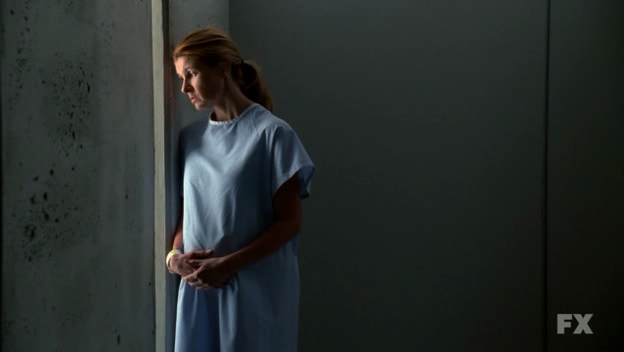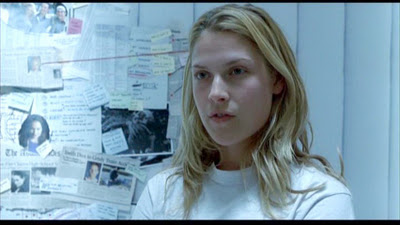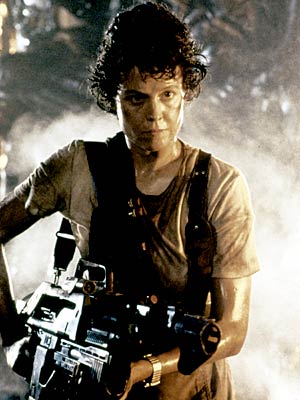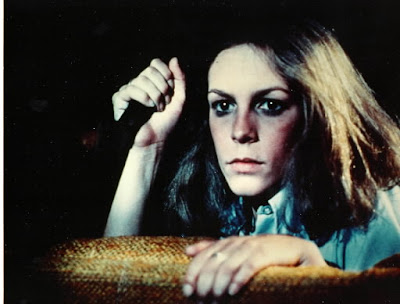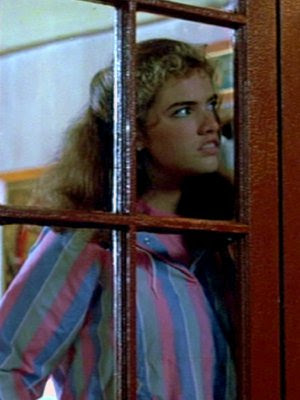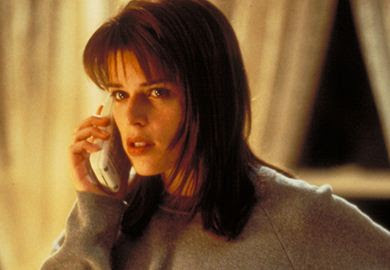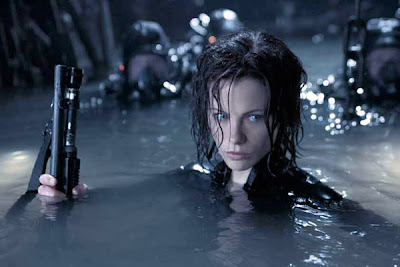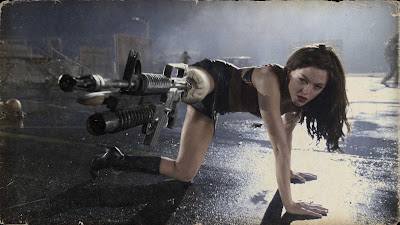 |
| Vivien (Connie Britton) in American Horror Story |
Ladies, how many times have you been called a “crazy bitch?” Once? Twice? 5 thousand times?? Or is that just me? This oh-so-not-lovely term of endearment gets tossed around waaaaayy too often. It’s bad enough when we get labeled the sexist term “bitch” — and it’s very different for us women to reclaim the word and its power, calling ourselves “bitch,” as we do here at Bitch Flicks. But it’s typically coupled with “crazy,” a problematic and offensive ableist term. Put them together and you have the Crazy Bitch, an all-too common trope in the media, appearing as victims and villains in horror.
Horror movies have undoubtedly been influenced by feminism. Some argue a “
stealth empowerment message” exists in horror films for women with lots of ass-kicking female survivors and the rise of the Final Girl. Sadly, not all tropes have fallen by the wayside, including the Crazy Bitch. Ableist and sexist stereotypes of women and mental illness abound in horror movies and TV (
American Horror Story,
Orphan,
Gothika,
Nightmare on Elm Street 3,
The Ring,
Misery, etc.).
Now, my mother and some of my friends live with mental illness. For each of them, it’s a part of their lives but it doesn’t define them. So I’m acutely aware of the stigmas, misconceptions and prejudices surrounding mental illness. Mental illness — from bipolar disorder, obsessive compulsive disorder (OCD) and depression to post-traumatic stress disorder (PTSD), schizophrenia and anorexia — is a legitimate medical condition requiring medication and/or therapy.
But I can’t tell you how many times I’ve heard people say mental illness isn’t “real” or they question why people with mental illness can’t get their shit together. Really, asshole? You wouldn’t dare say that to someone with diabetes or heart disease or cancer. So don’t say that ignorant shit. Ever.
Rather than dispelling myths, pop culture often reinforces mental illness stereotypes. As
Bitch Magazine’s s.e. smith asserts:
“For those of us with mental illness(es), pop culture can be a constant reminder of the fact that we are considered both scary and public property, objects of curiosity, fascination, and revulsion.”
 |
| Samara (Daveigh Chase) in The Ring |
And the Crazy Bitch trope helps perpetuate mental illness stereotypes. It has many sister tropes infesting horror too. Like the Hysterical Woman, where female characters are depicted as overly emotional and irrational, The Madwoman in the Attic, a trope where a character with mental illness is locked away, isolated from society, and the Nervous Housewife, where men doubt women’s paranormal experiences and patronize them. Jen Doll at The Atlantic Wire gives us “10 tropes about women that women should stop laughing about,” including “the crazy.” As Doll astutely observes, calling someone “crazy” is a way to put people (often women) down and for the accuser to feel better about themselves, all while being insulting to those who who struggle with mental illness.
The second season of the hit show
American Horror Story is titled
Asylum and set in a psychiatric institution. And of course the usual tropes emerge, like over-the-top shocking caricatures and the crazy nympho sexpots. But one of the most disturbing elements, besides the rampant gore, is when Sister Jude (Jessica Lange) utters, “
mental illness is the fashionable word for sin,” reinforcing the pervasive stereotype that mental illness isn’t actually real.
Cait at Feminist Film analyzes the mental illness tropes in American Horror Story: Asylum:
“To appropriate this traumatic history and use it as a measure of “freakiness”, to scare and shock viewers, as it explores this strange asylum with a serial killer who skins women, a doctor who performs Mengele-like experiments on patients who have no family or friends, nuns who dream about doing the deed and take their sexual frustration out in a weird form of repressed anger, and apparently, aliens, is exploitative and negates much of the positive aspects that the psychological field has accomplished…
“Horror does not equal shock value, and that is precisely what American Horror Story: Asylum is attempting to do. Where the first season left off on misogynistic representations of women and glorifying bad boy murderers, the second season picks up on the exploitation and stereotyping of mental illness. In a world where mental illness is already still heavily stigmatized, this is an ignorant and unnecessary bastardization of mental health practices.”
 |
| Lana (Sarah Paulson) in American Horror Story: Asylum |
But it’s not just the second season suffering from problematic depictions of mental illness. In season 1, Constance (Jessica Lange) calls her daughter Addie who has Down’s Syndrome a “mongoloid” and a “monster.” When Vivien (Connie Britton) says she was raped and she saw a ghost, her husband Ben (Dylan McDermott) doesn’t believe her and has her committed to a psychiatric ward. You know, because women can’t be believed or trusted. Because bitches be CRAZY!!
Creator and showrunner Ryan Murphy calls his TV series “
feminist horror.” And some even claim Sister Jude is a
secret feminist. Sure, there are plenty of interesting female characters. But that doesn’t automatically make it feminist.
Now, I don’t expect American Horror Storyto be sensitive or politically correct. Especially as gender and race problems clog up Murphy and Falchuk’s show Glee with its incessant problematic depictions of body image, race, gender and erasure of bisexuality. And the hospital staff in AHS: Asylum seems far more evil and sadistic than any of the patients. But considering the enormity of the stigma surrounding mental illness, the last thing we need is yet another movie or TV show perpetuating harmful stereotypes.
Many killers in horror films are unhinged or unstable, with many explicitly suffering from mental illness. In
Orphan, Kate and John adopt Esther (Isabelle Fuhrman) after a devastating miscarriage. Turns out, Ester is really a murderous 33-year-old woman with hypopituitarism, posing as a 9-year-old girl, who had been institutionalized in a mental hospital. In
Carrie, Carrie’s mother Margaret White (Piper Laurie) has a mental illness and repeatedly abuses and eventually attempts to kill her telekinetic daughter. While never explicitly stated,
Misery implies that torturous nurse Annie Wilkes suffers from bipolar disorder, as well as being a “
virtual catalog of mental illness.”
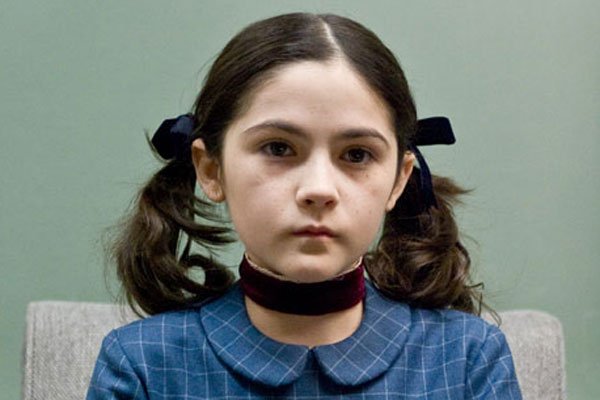 |
| Esther (Isabelle Fuhrman) in Orphan |
Ashley Smith asserts too many horror movies — like
Orphan — “send a false message of mental illness.” They correlate mental illness and extreme violence, an offensive and dangerous stereotype. We shouldn’t fear mental illness or people who live with it. Yet that’s the message continually reinforced.
But apparently it’s not just the living we must fear. In Hollywood, ghosts suffer from mental illness too. House on Haunted Hill (1999), Session 9, and Asylum all transpire in haunted psychiatric hospitals or asylums where the former living who struggled with mental illness become terrifying ghosts haunting the living. In The Ring, Samara is the girl responsible for the video tape that kills people. She tormented her adoptive mother as well as driving horses to commit suicide. Before she died, she was institutionalized in a psychiatric hospital. Then she becomes a murderous ghost. Naturally.
“Why would a mental illness like schizophrenia still plague someone after death? Would we expect a diabetic ghost to require insulin? A paraplegic ghost to require a wheelchair? Somehow, we’ve decided, the mentally ill are terrifying and threatening even when they’re dead. That seems unfair, given the stigma that they have to endure in life as well.”
Many horror films take place in psychiatric hospitals with women being committed because of their actions or recounting paranormal events. After protagonist Kristen battles Freddy Krueger in
A Nightmare on Elm Street 3: Dream Warriors, her mother erroneously thinks she was attempting suicide and hospitalizes her. Similar circumstances cause Kirsty in
Hellbound: Hellraiser II to be hospitalized. In
Gothika, Miranda (Halle Berry) is a psychiatrist who becomes institutionalized after she’s accused of murdering her husband. Her former colleagues think she’s delusional and suicidal after she tells them she sees ghosts. Miranda’s former patient Chloe (Penelope Cruz) — who Miranda didn’t believe was being raped, thinking she was fabricating the trauma — tells her, “You are not a doctor in here. And even if you tell the truth … no one will listen. You know why? Because you’re crazy.”
 |
| L-R: Chloe (Penelope Cruz) and Miranda (Halle Berry) in Gothika |
In American Horror Story and many of these films, the women aren’t believed. As a result, they’re deemed dangerous and erroneously labeled mentally ill. Removed from society, they are punished for their actions.
Yes, we do see men struggling with mental illness in horror films. Halloween, Shutter Island, In the Mouth of Madness, and The Shining are all examples of men struggling with mental illness or in psychiatric hospitals. But despite the Final Girl in many horror films, we still see a wider variety of men represented. And men don’t have to worry about being labeled “crazy” the way women do.
“Reflexively calling women “crazy” is a habit young men need to learn to break. As a term, “crazy” is entirely of a piece with the long and nasty tradition of pathologizing female emotion (and particularly sexuality). Hysteria comes from hystera, the Greek word for uterus, after all: “crazy” has been a gendered trait in Western culture for thousands of years. The male gaze was for virtually all of human history synonymous with the medical gaze, and men assigned themselves the authority to determine which bodies are sick and which are hale.”
In his popular post, “
A Message to Women From a Man: You Are Not ‘Crazy,’” Yashar Ali argues that men often call women crazy to emotionally manipulate them. He discusses “gaslighting” (taken from the classic film
Gaslight with Ingrid Bergman), in which men diminish women’s concerns by dismissing them, making them neurotically question their perception and themselves. I’ve accused many men in my life of doing this — trying to mansplain to me and make me doubt myself. Ali explains why gaslighting affects so many women, regardless of their self-confidence:
“Because women bare the brunt of our neurosis. It is much easier for us to place our emotional burdens on the shoulders of our wives, our female friends, our girlfriends, our female employees, our female colleagues, than for us to impose them on the shoulders of men. It’s a whole lot easier to emotionally manipulate someone who has been conditioned by our society to accept it. We continue to burden women because they don’t refuse our burdens as easily. It’s the ultimate cowardice.
“Whether gaslighting is conscious or not, it produces the same result: It renders some women emotionally mute.”
Society polices women’s appearances, language and behavior. We can’t let the ladies get out of control. Who knows what could happen??? Calling a woman “crazy,” doubting not only her veracity but her very sanity, is offensive. It’s also an attempt to control women, demean them and strip them of their power. Women with mental illness are often silenced, invisible from the media aside from victims or villains in horror. When we do see them on-screen, they instill fear as they are depicted as violent, volatile and uncontrollable.
 |
| Annie Wilkes (Kathy Bates) in Misery |
Gender Focus’ Jarrah Hodge writes about mental illness tropes in all films:
“Because women have been historically branded as “hysterics,” and women are oppressed in the media in general, women with disabilities report feeling particularly harmed by media misrepresentations of their realities…From the Joker in The Dark Knight to Angelina Jolie’s character in Girl, Interrupted, people with invisible disabilities (disabilities that aren’t physically apparent, including mental illness), are often portrayed as dangers to society who need to be contained and/or ‘fixed’.”
Horror movies aren’t necessarily about portraying mental illness (or anything for that matter) accurately. They strive to push boundaries, spurring us out of our comfort zone. They strip everything away to its visceral core. But it’s highly problematic the Crazy Bitch trope keeps appearing on-screen.
It might not be such a big deal if the media showcased positive representations of mental illness to counter or balance those we see in horror movies and TV series. But we rarely do. Women in general are continually portrayed as illogical, overly emotional, unreliable and unbalanced. The media often dehumanizes women with mental illness, depicting them as dangerous, brutal and sadistic. The perpetual message is that we need to be rescued from women with mental illness as they are a threat to not only themselves but to society.
The “crazy bitch” label — in both pop culture and reality — silences and dismisses women while simultaneously shaming and stigmatizing women living with mental illness. So Hollywood, let’s stop with all the prejudicial bullshit and just show us what we all really want to watch…a zombie apocalypse.






